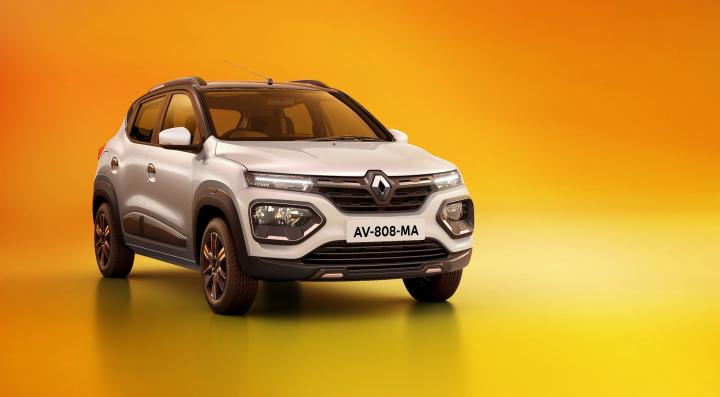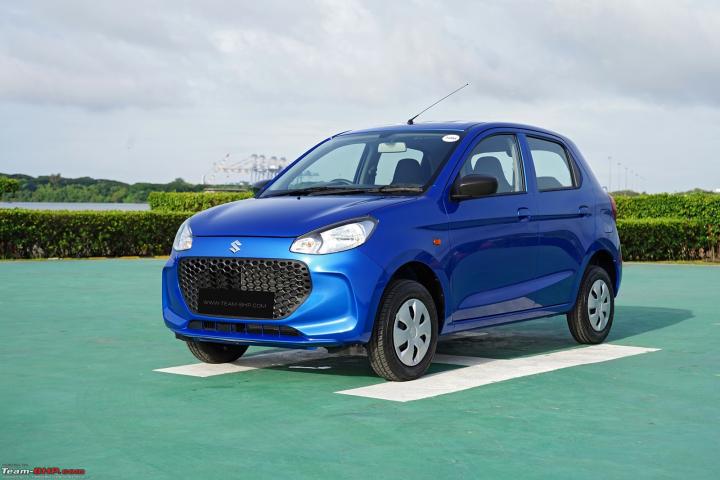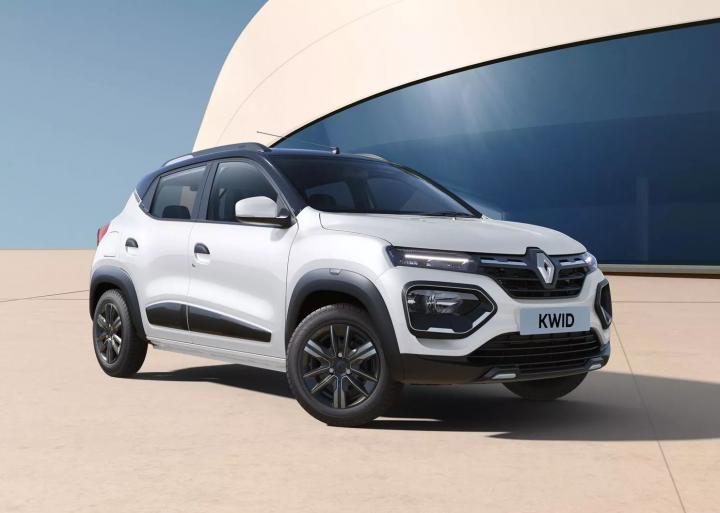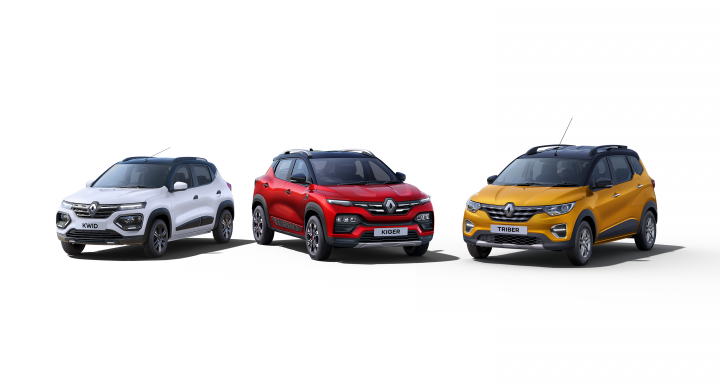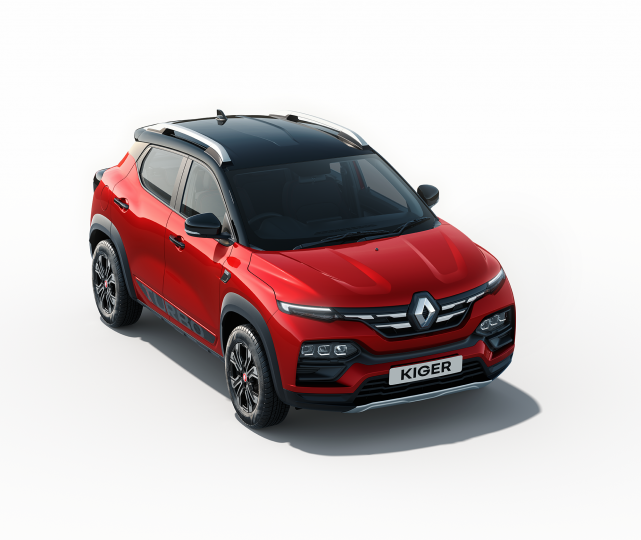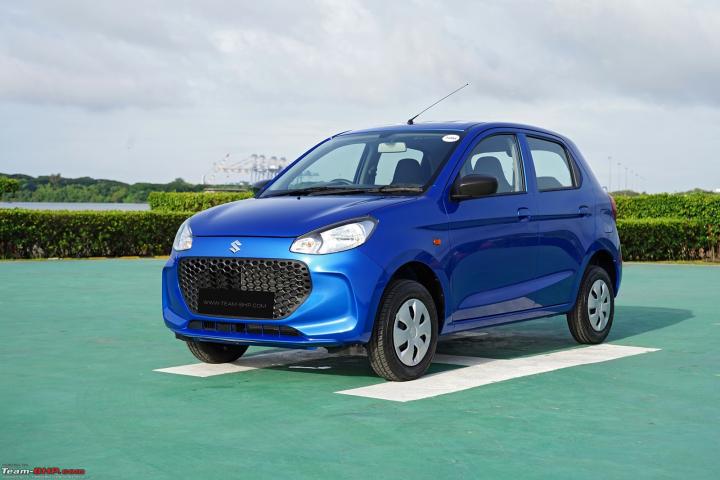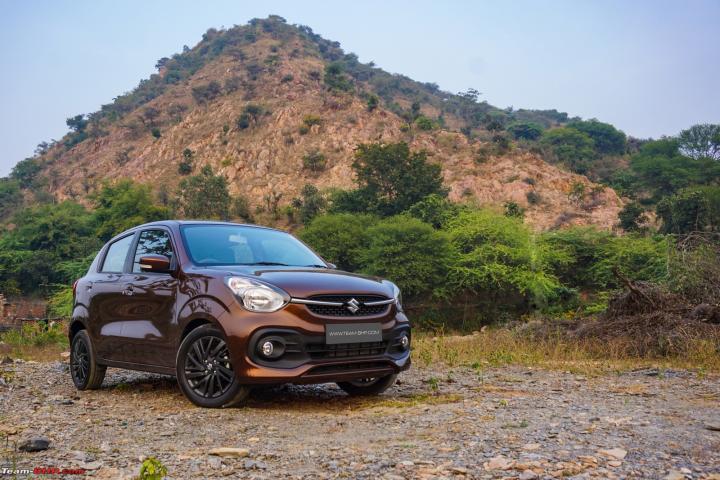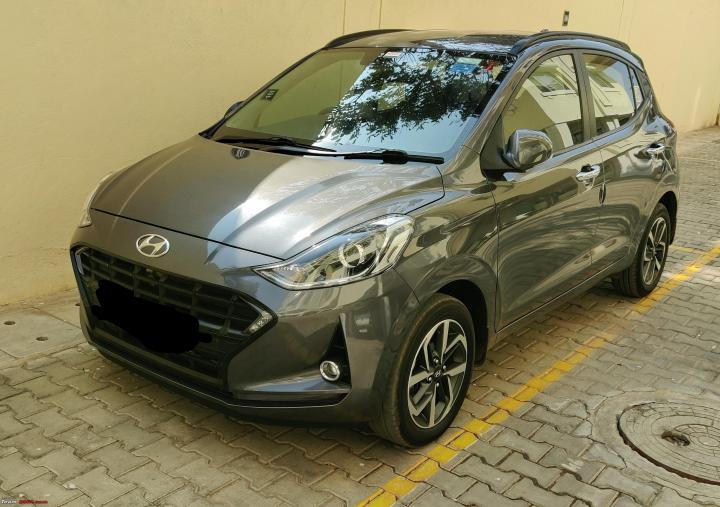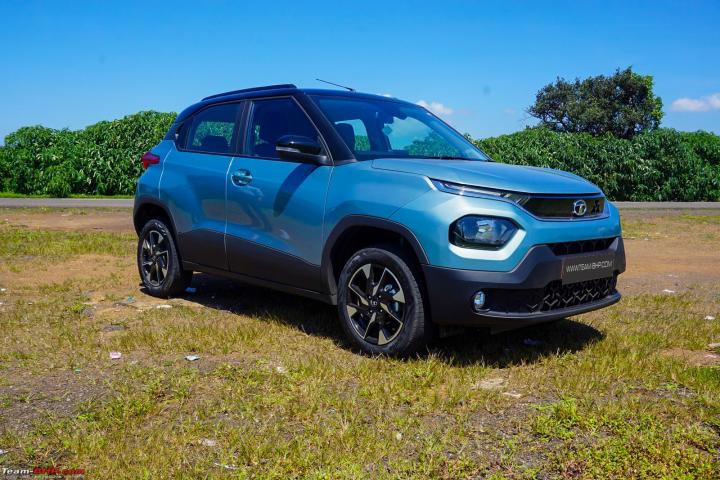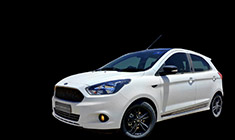News
2024 Renault Kwid launched at Rs 4.69 lakh
The updated Kwid is available in seven variants.
Renault has launched the 2024 Kwid in India. The updated Kwid is available in seven variants, priced from Rs 4.69 lakh (ex-showroom).
Renault has made a few changes to the feature list and introduced new dual-tone colours. The mid-spec RXL (O) variant now gets an 8-inch touchscreen infotainment system. It is also available with an automated manual transmission (AMT).
The Kwid is powered by a 1.0-litre, 3-cylinder petrol engine that makes 67 BHP and 91 Nm. The engine is mated to either a 5-speed manual or a 5-speed AMT.
2024 Renault Kwid ex-showroom prices:
- RXE MT – Rs 4.69 lakh
- RXL (O) MT – Rs 4.99 lakh
- RXL (O) AMT – Rs 5.44 lakh
- RXT MT – Rs 5.50 lakh
- RXT AMT – Rs 5.95 lakh
- Climber MT – Rs 5.87 lakh
- Climber AMT – Rs 6.12 lakh
- Tags:
- Indian
- Renault Kwid
- Kwid
News
Why are Entry-level cars falling out of favour?
There is a big section of Indian society who are restricted to two wheelers only because of budget constraints and many of them migrate to entry level cars as and when possible.
BHPian cludflare recently shared this with other enthusiasts.
Buying a first car can be a very difficult discussion for many. With India shining, most of us would end up owning at least 4 to 5 cars in our lifetime if not more. But the first one is always special. There are different opinions that people hold around first cars – some believe a used car is the best way to get your hands accustomed and then move to a new one, some believe that in the new age one can directly own an automatic and skip the manual world completely, some do not want to compromise on safety these days at all, while for many it’s a pure decision of affordability.
There is a big section of Indian society who are restricted to two wheelers only because of budget constraints and many of them migrate to entry level cars as and when possible. This is one space that I have a particular interest in. I live in Bangalore and often notice that there is an increasing drop in the number of Altos and Celerios on the road, which is understandable with Bangalore having the highest per capita income in the country. But unlike the big cities, this segment is extremely important for a massive part of India. For many of us, the first car was always an entry level car which might be changing now.
Maruti Suzuki’s chairman recently shared his view in their half yearly press conference about the significant drop-in entry-level car-space.
The objective of this post is to have some discussion around the lack of options and OEMs disappearing from this space and second, the importance of safety features in the segment.
Even if MSIL’s sales numbers from this segment remain high, this is not a value segment. I have deep respect for Maruti Suzuki to continue to focus on the demography that buys their first car based on affordability. Decade over decade, Maruti has ensured that the Indian customer is not running out of options at all non-premium price points. While others like Hyundai chose to fold, Maruti holds the fort. It was extremely sad to see first the Eon followed by the Santro coming under the axe. The cheapest Hyundai (Nios - Era) now costs 7 lakhs on road. On the other hand, Maruti still offers the lower middle class buyer the option to chose from Alto, Celerio, Wagon R and even the Ignis priced aggressively. Also notable mentions are the Kwid and Tiago still being around.
I understand that with the commodity costs on the up and the tax treatment for foreign players (excluding Koreans) makes the business less viable in this segment. That makes me think about the mandate of having 6 airbags for all cars. I do believe safety is very important aspect of a car, and it should be one of the top priorities for all car buyers, if you can afford it. But there are millions of Indians who will want to upgrade to an entry level hatch from their scooters – don’t bump in their costs.
Kudos to Tata Motors for raising our awareness towards safety, but hey – don’t mock S-Presso in your social handle for 0 stars. You are not the one offering a car at 4 lakh ex-showroom.
Here's what BHPian The_Rationalist had to say on the matter:
You are simply nitpicking on TATA. The cheapest car, Alto costs ₹4.6 lakh in Kerala, Tiago costs ₹6.6 lakh. In EMI terms it’s around ₹4000. There will be very minuscule percentage of people who can afford a Alto but not a Tiago! The sales of the cheapest 3 cars in India is <5% of total sales! So the percentage who can’t afford a Tiago, yet able to afford an Alto will be less than 5% of car buyers.
Let us assume a person wants to buy a car. I bought my first car 20 years back, it was an used Zen, I drove it for 14 years. Mind you there were less options then. Now for the cost of an Alto you can get lot of good used cars. So, it is not that cost of entry level cars is high, the country has grown up in income and that is reflected in car sales. My first car was bought for ₹3 lakh in 2002, so with regard to inflation the car prices has not grown that much. ₹3 lakh in inflation terms would be ₹11 lakh now. That means while the former could only afford me a Zen, that too a used one, now for same inflation adjusted money I can almost get a new Virtus/Slavia! We can simply crib on imaginary issues, while the fact is entirely different.
Here's what BHPian Aakash118 had to say on the matter:
More than anything, it’s the decreasing aspirational value of cars like Alto & Celerio which is responsible for downfall of this segment. I know at least 3-4 people in my circle who bought their first car in the form of a used i10 or Ritz, learned driving on it and then directly upgraded to a Nexon or Creta. A new Alto or even Tiago is just not aspiring enough for them.
Here's what BHPian ninjatalli had to say on the matter:
Buying a car is a big jump for a lot of middle-class Indians; but for the same, the decision also focuses on maintenance costs. And with regards to that aspect, Maruti leaps ahead by a huge margin. In reality, the cost of ownership for a Maruti might not be very far from a Hyundai in the same segment, when serviced at regular service centers. But from a mindset, Maruti still screams as value-for-money for the average fellow on the road. And that also gets revalidated when one goes to an FNG or tries to sell an existing Maruti car.
I believe the likes of Hyundai, Tata and others have realized they can't fight this and have "shifted" their entry level segment range while focusing on other aspects (e.g. safety, gadgetry). Maruti would love to do so but the bottom of the pyramid is still a cash-cow for them (even if the margins are very low) and hence they have to make-do with whatever possible (e.g. limited safety features). I expect over time the old models (Alto, etc.) will be phased out eventually.
Here's what BHPian M_powerred had to say on the matter:
I believe its the easy availability of EMIs and loans. People with jobs can easily sign a few documents and add one more year to their loan tenure and get a car thats segment above. Hence everyone is going for it. Since the idea of having more than one EMIs is getting accepted by the younger earning population, from EMIs for the new iphone and a car feels mostly similar. So why not? Is the question of the new earners. I am not saying anyone is being financially irresponsible with their funds, because at the end YOLO...
Here's what BHPian rishi.roger had to say on the matter:
There is not a substantial difference between 5 lakh and 10 lakhs these days. If someone can purchase a 5 lakh car, buying a used or even a new 8-9 lakh car won't be very difficult. Thanks to the financing scheme provided by banks, and also a change in purchase mentality in modern Indian population (particularly those in Metro/Tier-1 and some Tier-2 cities).
Social media content also has a lot of influence on the youth.I think the puzzle could be solved further if one gets their hands on amount of cars that have been sold on loan, % of loan amount and age groups they're sold to.
I feel, A lot of people buying cars these days are youngsters, who don't mind the burden of EMIs as they see a bright future for Indian economy. They understand that for sure, they could get an Alto right now but soon enough they'll earn more and desire more - so why not put their money somewhere that's also slightly future proof in terms of meeting the desire/needs.
Read BHPian comments for more insights and information.
News
A brand new hatchback on a 6L budget: Alto K10 vs Celerio vs Kwid
The Kwid looks light and good, while the WagonR is not aesthetically pleasing, but I believe it offers more interior space.
BHPian raptor_diwan recently shared this with other enthusiasts.
I am looking to buy a second car for city rides, mainly with an automatic transmission. My budget is 5 Lakhs, and I have checked the used car market, but I am not satisfied with the way they have been maintained. Now, I am slightly extending my budget to 6 Lakhs and planning to buy any one of these cars new with an automatic transmission.
I am confused between these three options. Personally, I am not happy with the way the Celerio and Alto look. They don't suit my body shape, and I feel they might appear too small when I sit in them. The Kwid looks light and good, while the WagonR is not aesthetically pleasing, but I believe it offers more interior space.
Is the Kwid more spacious than the WagonR? Can the Kwid provide better mileage than the WagonR? The WagonR AGS claims to have a mileage of 25, but even if it's 18, it's acceptable to me.
Here's what BHPian tharian had to say on the matter:
Let me help in terms of the WagonR query only. I have no idea about the Kwid , nor the new Celerio or Alto.
The new WagonR is a spacious car, I am sure it is bigger than the Kwid on the inside. It is the perfect car for city use because of the easy ingress/egress and being a small footprint car, it easy to drive. We have one at home since early last year which was bought as a replacement for an old Swift, for my father who is in his mid-70's and drives to work everyday. So I opted for the AMT 1.0 version knowing that is sufficient for his use.
Fast forward around 6000 kms and 18 months, except for some dents and scratches due to parking, the sheet metal is as good as a cola can, the car is perfect for him and as well as me to use it for short distances. More than enough space on the side, including a decent sized boot.
On the fuel efficiency front, the car has been giving a consistent 12 kmpl with AC in city use. So you can confidently ignore the advertised figures.
There is no wheel cladding or noise deadening in the car, it feels like I am driving a 800 in the 90's. Same with the shocks and add to that the hard MRF tyres, a pothole if not avoided, hits with an impact in the cabin and on passengers.
The AMT needs to get used to. Now I am used to letting go of the accelerator to shift gears and I don't let the ECU do that. It works out more comfortable and predictable this way. But I heard the AMT is better on the updated version of the car launched last year.
End of the day, I would recommend it as a family city car or for ageing parents.
Here's what BHPian AYP had to say on the matter:
Before I state my opinion, I'd like to let you know that none of these cars shall fit in your budget of 6L. The cheapest automatic in India is the Alto K10 VXI which costs 5.61L ex-showroom and should cost around a lakh more on road in Chennai. This is the car which shall allow you to stick the closest to your budget.
If budget is no bar, the WagonR is the best choice in the 1.2 guise though. The WagonR 1.2 ZXi AMT costs only about 30k more than the 1.0 VXi and is actually more fuel efficient. The extra features and the peppier engine shall be an added bonus. Kwid is a good car(and it offers a tachometer as standard) but the Kwid AMT does not have a manual mode unlike the other cars. A manual mode may come in handy during some tricky situations. Due to this omission in the Kwid, I'd personally avoid it.
Between the WagonR 1.0 and the Celerio 1.0, while you have stated the Celerio is not to your liking, it does come with a tachometer(if it matters to you) and a better instrument cluster with a mode modern design while costing you 15k less. The power window placement is an issue though.
Here's what BHPian bijims had to say on the matter:
Before I state my opinion, I'd like to let you know that none of these cars shall fit in your budget of 6L. The cheapest automatic in India is the Alto K10 VXI which costs 5.61L ex-showroom and should cost around a lakh more on road in Chennai. This is the car which shall allow you to stick the closest to your budget.
If budget is no bar, the WagonR is the best choice in the 1.2 guise though. The WagonR 1.2 ZXi AMT costs only about 30k more than the 1.0 VXi and is actually more fuel efficient. The extra features and the peppier engine shall be an added bonus. Kwid is a good car(and it offers a tachometer as standard) but the Kwid AMT does not have a manual mode unlike the other cars. A manual mode may come in handy during some tricky situations. Due to this omission in the Kwid, I'd personally avoid it.
Between the WagonR 1.0 and the Celerio 1.0, while you have stated the Celerio is not to your liking, it does come with a tachometer(if it matters to you) and a better instrument cluster with a mode modern design while costing you 15k less. The power window placement is an issue though.
Here's what BHPian mgastor2022grey had to say on the matter:
I will recommend to you the Kwid Climber AMT. There is one in my near family, and I got to drove it a couple times. My observations are:
- Good and spacious car, when compared to my friend's WagonR.
- A great looker, better than the WagonR.
- Though Mediocre interiors, they definitely feel upmarket and is safe by Renault standards.
- You might want a Renault badge over a Maruti Badge IMHO.
- Beautiful looking car, compared to the WagonR (I hate the tallboy design).
- Better high speed stability than the WagonR due to better aerodynamical phase.
If you are looking for other cars, will suggest you the Tata Tiago/Tigor. Amazing safety and best looking designs, both inside-out.
Read BHPian comments for more insights and information.
News
Renault Kwid 800cc discontinued in India
Prices for the Renault Kwid 1.0L start at Rs 4,69,500.
Renault has phased out the 800cc version of the Kwid following the rollout of the BS6 Phase 2 emissions norms.
The Kwid 0.8L was the entry-level version of the hatchback and was available in RXL and RXL (O) trims. The 800cc, 3-cylinder engine produced 52 BHP and 72 Nm. It was paired with a 5-speed manual gearbox.
Going forward, the Kwid will be available with the 1.0-litre petrol engine only. The 999cc, 3-cylinder unit produces 67 BHP @ 5,500 rpm and 91 Nm @ 4,250 rpm. It is paired with either a 5-speed manual or a 5-speed AMT.
Prices for the Renault Kwid 1.0L start at Rs 4,69,500, with AMT available from Rs 6,12,500 (ex-showroom).
- Tags:
- Indian
- Renault Kwid
- Kwid
- Discontinued
News
Renault launches the 2023 Kiger, Triber & Kwid in India
Renault's 2023 model range has been updated with new safety features and RDE-compliant engines.
Renault has announced the launch of its 2023 model range, which includes the updated Kiger, Triber and Kwid.
Renault’s 2023 model line-up comes with updated engines that comply with BS6 Step 2 emission norms. In addition to catalytic converters and oxygen sensors, the cars are equipped with a self-diagnostic device, which constantly monitors the vehicle’s emission levels while driving.
As far as safety systems are concerned, Renault has made features like Electronic Stability Program (ESP), Hill Start Assist (HSA), Traction Control and Tyre Pressure Monitoring System as standard on the 2023 Kiger and Triber. These features are also available in select variants of the 2023 Kwid.
The 2023 Renault Kwid is available in a new RXE variant powered by a 1.0-litre engine. It is priced at Rs 4.69 lakh (ex-showroom). The car also gets features like ORVMs with integrated turn indicators and steering-mounted audio and phone controls.
On the other hand, the 2023 Renault Triber gets chrome door handles and new seat upholstery.
News
Sales performance of cars that won the TeamBHP Car of the Year
Kia Seltos is the most successful TeamBHP Car of the Year.
BHPian pqr recently shared this with other enthusiasts.
Sales performance of Team BHP CoTY



- Hyundai, Maruti, and Toyota never won Team BHP CoTY title despite delivering some real sales champions in a few segments.
- Despite bringing in some enthusiast-appealing cars, VAG never won Team BHP CoTY title.
- Two cars of the year were flops: the Tata Nano and the Mahindra Marazzo.
- SUVs always got over 40% of the votes while winning the yearly contest.
CoTY is awarded in the launch year, however, products have to live long and sustain sales throughout the product-life-cycle (PLC) and even after generation changes. Here is the analysis of PLC sales volume to review actual sales performance.
2009 Tata Nano & 2016 Tata Tiago

The Tata Nano was one of the most innovative but overhyped product, which gave a lot of nightmares to Osamu Suzuki (Chairman Suzuki Motor) before 2010. Nano was supposed to sell around 2.5 lakh units annually; however, total lifecycle sales could reach only 3 lakh units as Nano was completely rejected by the Indian audience. Even Tiago’s sales were higher.

Tata Tiago was the spiritual successor of Tata Indica, however, it never attained the market share that Indica had in the past. Tata Altroz, launched in 2020, attained a higher market share than Tiago in 2021. So as a turnaround project, Tiago served its purpose but was not quite a match for its predecessor or a sales benchmark in the industry. Despite being cost-competitive, Tiago has established the appropriate safety standard in the industry.
2010 Ford Figo

The first generation Figo was a success until the facelift, after which the Figo lost its way, and the second generation was a disaster, leading to Ford's exit from India.
2011 Mahindra XUV 500 & 2021 Mahindra XUV 700

The XUV 500 was a runaway success, and so is the XUV 700. However, PLC management was not that great for the XUV 500, and it suffered a lot towards the end when the next generation was desperately needed. If Mahindra had ramped up the production capacity of the XUV 500 to the 2011 wholesale level, then the underutilization of plant capacity would be over 1.6 lakh units till 2021.

With a 5-star crash test safety rating, powerful and diverse drivetrain choices, better suspension, and a tech-loaded package, Mahindra has provided much stronger armour to the XUV 700 to stay competitive in the long run. Despite a strong order bank, it is time for Mahindra to not get complacent and strive for a higher market share.
2012 Renault Duster

If a product strikes the right chord with a potential customer segment, then what’s in the name? Duster was a definitive product that gave birth to a soon-to-be hot and aspirational segment and did well in the early part of PLC. Renault, however, failed to properly plan and execute the Duster's lifecycle, resulting in the product's discontinuation in 2021.
Duster couldn’t score a four-star rating in the GNCAP crash test; however, successive products like Triber and Kiger scored well despite having a very low entry price point.
2013 Ford Ecosport

A definitive product that never lost its appeal despite increasing competition. If Ford India hadn’t become so complacent on Ecosport, then it could have done even better.
2014 Tata Zest

As a turnaround and bridging project, Zest simply served its purpose. A four-star safety rating in the GNCAP crash test was a commendable achievement for Zest.
2015 Renault Kwid
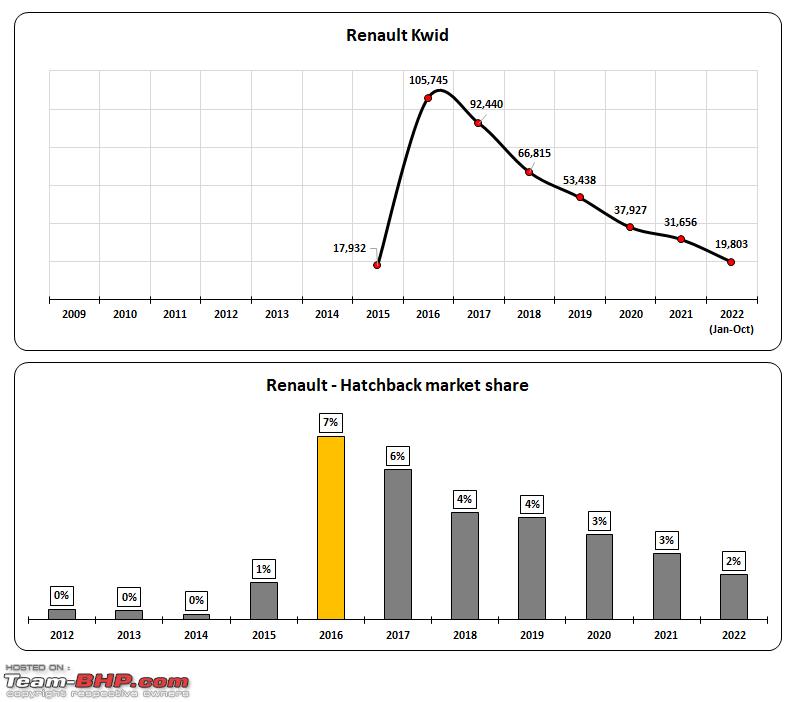
Maruti, Hyundai, and Tata have commanded 84% to 97% of the hatchback market share between them since 1998, thus leaving less room for others to succeed. So Renault came up with a path-breaking product and achieved remarkable success with a 7% hatchback market share in 2016. But then complacency set in, and Renault, being the typical poor parent, again forgot to manage the PLC of the Kwid well, resulting in poor sales after 2017.
2017 Jeep Compass

Besides being compact premium offerings, the Jeep Compass, Skoda Yeti, and Hyundai Tucson have one thing in common: a 2L diesel engine option. Compass is locally manufactured in India and exported to other RHD countries, whereas other two had a CKD operation. Thus, Jeep Compass pricing was competitive (relatively) at the time of launch, thus creating a much bigger market for itself than others. The rest of the PLC is simply a roller coaster ride, as the graph suggests.
2018 Mahindra Marazzo

Kia Carens has done what Mahindra couldn’t do with the Marazzo. That is, finding a place to live and thrive even while sandwiched between the Maruti Ertiga, the XL6, and the Toyota Innova. Marazzo had the safest rating among all competitors, with a four-star GNCAP crash test rating.
2019 KIA Seltos

Kia Seltos is perhaps the most successful TeamBHP CoTY, as demand is still strong even after three years of existence and cars are selling without discount. It checked all the boxes that Indian customers value, except for safety. It seems that particular box doesn’t exist. Still, it could not topple the Hyundai Creta in 2020, as the latter has changed the rules of the game with the first panoramic sunroof in the segment.

Together, Hyundai and KIA have decimated the competition in 2020.
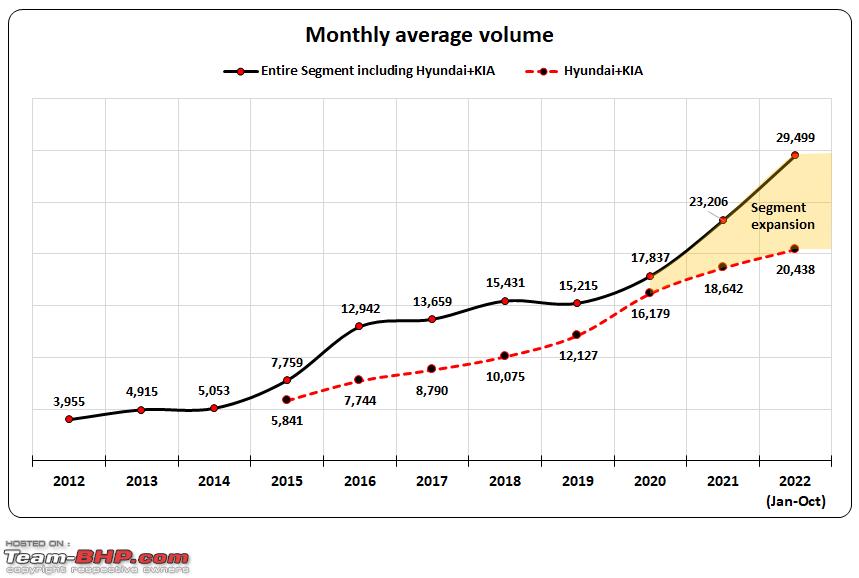
Challengers have re-emerged, but they expanded the segment rather than hurting Hyundai-KIA’s volume.
2020 Mahindra Thar

The changed value proposition—easy to live with every day as an off-roader—of the Thar second generation has changed the game for Mahindra. Now, it appeals to city dwellers with different lifestyle aspirations. In reality, Thar is purchased more for show than for any serious off-road adventure. However, Mahindra has correctly identified a previously unseen emotional need and has shown the courage to develop and deploy a petrol engine for Thar, along with an automatic transmission. Some are trend followers, and some just create one with the Jeep Wrangler concept and design rip-off. What differentiates the Thar from the Wrangler is a good score in the safety crash test rating.
Team BHP CoTY GNCAP safety rating

Read BHPian comments for more insights and information.
News
2022 Maruti Alto K10 vs Renault Kwid vs Maruti Celerio
The 4-cylinder petrol gives the WagonR the best performance & refinement of any car listed here.

2022 Maruti Alto K10

Maruti Alto K10 Pros
- A much improved, well-rounded city car as compared to the outgoing generation
- Peppy performance with a healthy power-to-weight ratio
- Excellent fuel efficiency. ARAI figures: 24.90 km/l (AMT) and 24.39 km/l (MT)
- Convenient AMT available at a premium of Rs. 50,000 makes it the cheapest automatic car available in India
- Sufficient cabin space to accommodate four 6-footers
- Small dimensions, good visibility, light controls, AMT transmission & a tiny 4.5 m turning radius make it a great choice for city driving as well as first-time car buyers
- Good touchscreen ICE with Android Auto + Apple CarPlay + steering mounted controls
- Maruti's fuss-free ownership experience & widespread dealer network
Maruti Alto K10 Cons
- Significantly more expensive compared to the previous generation
- Narrow width makes it a strict 4-seater
- Basic ride quality. Feels wobbly over rough patches and can bottom out on when going over larger potholes
- Poor high-speed dynamics & NVH. Best driven at double-digit speeds
- Skinny low grip 145 mm tyres given the power on offer
- Missing essentials such as rear power windows, rear wiper/defogger, day/night IRVM, etc.
- Light, economy-grade build quality. Sibling S-Presso scored 0 stars in the GNCAP crash tests
- S-Presso offers a lot more at just ~15,000 more (greater space, larger wheels & tyres, body-coloured and electrically adjustable ORVMs, features like ESP with hill-hold (AMT)), etc.
Maruti Alto

Renault Kwid

Maruti Celerio

Maruti S-Presso

Maruti S-Presso Pros:
- Funky design stands out from the crowd
- Well-priced for what it offers
- Spacious cabin with enough room for four 6-footers, and easy ingress/egress too
- Fantastic engine & MT gearbox. Fun, driveable, rev-happy, fuel-efficient
- Optional AMT automatic available at an Rs. ~43,000 premium
- 180 mm of ground clearance & a tiny 4.5m turning radius aid practicality
- Boot has a practical layout. Rear seat does fold down when required
- Nice touchscreen ICE with Android Auto + Apple CarPlay + steering mounted controls
- Maruti's fuss-free ownership experiences & widespread dealer network
Maruti S-Presso Cons:
- 0 stars in the GNCAP crash tests (full discussion)
- Controversial styling with oddball proportions – you’ll either love it or hate it
- Basic ride quality has a distinctly firm edge to it. Can get bumpy
- Terrible highway dynamics & NVH at 100 km/h. Best driven at double-digit speeds
- Weird, poorly-calibrated steering has many flaws
- AMT, although improved, can’t match conventional ATs on smoothness & speed. Still gets jerky
- Narrow width makes it a 4-seater (not 5)
- Missing rear power windows, rear defogger & day/night IRVM
- Skinny 165 mm tyres or atrocious 145 mm rubber (lower variant). Fuel tank is just 27L in size
Maruti WagonR

Maruti WagonR Pros:
- Unbeatable practicality, with a value-for-money price tag
- Spacious interiors. Ingress & egress are effortless too
- 340-liter boot has almost doubled in size (compared to the old WagonR)
- Awesome 4-cylinder 1.2L engine costs just Rs. 20,000 more than the 1.0L
- Suspension offers a more compliant ride than the outgoing car
- Features such as the touchscreen head-unit, under seat drawer & well-priced 2nd airbag
- Maruti's fuss-free ownership experience & excellent after-sales service
Maruti WagonR Cons:
- Interior quality is budget grade. The Santro is in another class altogether!
- Thin & tinny sheet metal. The car feels lightweight when driving as well
- Lousy NVH package. Insulation is quite poor
- AMT – although improved – cannot match the Santro AMT’s smoothness
- Road manners make it more suited to the city than the highway. Keep your speeds in check
- Some misses like no alloy wheels, missing rear speakers & useless rear headrests
- Superior Ignis isn’t priced too far away, especially after discounts
Tata Tiago

Here's what GTO had to say on the matter:
Would spend a little more and go for the WagonR, with that wonderful 1.2L petrol engine. The 4-cylinder petrol gives the WagonR the best performance & refinement of any car listed above. Plus, the new WagonR doesn't look bad for a breadbox. Most practical, spacious, has a big boot and a comfortable ride. IMHO, it's the best out here and a perfect family-beater.
Here's what BHPian DicKy had to say on the matter:
It is Alto K10 vs Spresso vs WagonR 1.2 for me.
It is hard to choose between the Alto K10 vs Spresso, though in AMT guise S-Presso wins hands down with the hill hold and ESP.
WagonR 1.2 would have been my choice if the present WagonR had practical interiors like the previous generations. Yes, space is there, but storage spaces and cubbyholes are in such shortage, that the dashboard looks just like a glorified plastic tablet holder! Add to that, if you buy the WagonR 1.2, you will get the far superior Ignis for the same price. (if you don't care for stuff like touchscreens)
So my choice is the S-Presso.
Here's what BHPian agambhandari had to say on the matter:
A base model Ignis Sigma comes out to be cheaper than a Wagon R 1.0 and cheaper than Celerio VXI. And this is with the usual 20-25k discount. We bought one a couple of months back and if you drive these cars back to back, it's not even a contest. The K12 in the Ignis is miles ahead of the K10C and heck even the K12C in terms of power delivery yet returns very good FE. The equipment in the Sigma is also comparable to this VXi Celerio and Base WagonR.
So my choice would be the Ignis.
Check out BHPian comments for more insights and information.
News
Advice needed: A replacement for my Tata Nano AMT on a 7 lac budget
Primary contenders include but aren't limited to the Renault Kwid, Maruti Alto K10, Maruti Ignis and the Grand i10 NIOS.
BHPian MADisMynAMe recently shared this with other enthusiasts.
I am in a dilemma of purchasing a reliable, easy to run car for the city. The below, is what is required in the new car. (I have not specified them in order so forgive me for that). This is a lengthy thread, so please bear with me.
- Space (Our Nano and Seltos have pampered us)
- Fuss-free service
- Hassle-free gearbox
- An adequate engine with good FE
- Good headroom and high-seating
- Features (Fog lamps, Wheel covers, Defogger, Rear Power windows)
- VFM price
- Not a demo/used car
We had ignored some vehicles right from the start:-
- Datsun Go and Go+:- Low sales and poor service with lack of spares.
- Tata cars:- Service experience, AMT issues (Further specified below).
- Renault Triber:- The 7 seats would never be used.
- Sedans:- Too long for the city.
- Mahindra KUV1OO NXT:- Boring looks and lack of spares with the concern of discontinuation.
These were the cars initially considered but dropped:
- Maruti Alto (800):- Small, spacious enough with basics covered for 5 lakh OTR was quite VFM for us. However, it was a manual and the fact that the new one was around the corner made us wait. After seeing the K10, this feels plain-jane.
- Datsun Redi-Go:- Parents hated the looks, brand value was average and space was less. But it was quite VFM for a 1L engine with AT for 5 lakh OTR. We almost booked it but we were inclined more towards the Kwid. Now that Datsun is gone, I feel it was a great city car spoiled by the brand.
- Maruti S-Presso:- It looked quite spacious and feature-rich in the videos. However, upon seeing it in real life, we found it like a butter box on wheels with 0 star safety and a few features over the Nano (Touchscreen only to be precise!). Dropped ASAP.
- Citroen C3:- Dad loved the looks but it was a manual only with basics missing at a high asking price. Lack of showrooms in Goa was also a big let down and a question on the spares of the cars ran around our minds.
- VW Polo (GT):- The car was my choice (Quick, nimble FTD DNA). But the space and looks were a let down and the asking price was above budget.
- Hyundai I20 (N-Line):- My choice again but too powerful and out of budget.
Cars considered:-
- Maruti Alto K10:- Upon launch, we loved the looks and the features offered were good enough for us. It was also spacious inside and the price of 6.25 lakh OTR for the base auto was quite VFM.
- Renault Kwid:- The car was loved by my father till the launch of the Alto K10. Still he likes the features it offers, it's looks and the price tag.
Other cars above the price which were liked and can be considered:-
- Maruti Ignis:- Dad liked it for it's funky design, good feature list and the ambience of the vehicle.
- Hyundai Grand I10 Nios:- The car looked smart, feature rich and the interiors were gorgeous.
- Renault Kiger:- The car looked compact, funky and the colours were fab! He loved it and the NA engine is his choice.
- Maruti Baleno:- My sister liked it's design and the feature-set reminded us of our Seltos (HUD, 360 camera). The car can be considered.
- Maruti Brezza:- The design was liked and the stance was high. It was quite premium and the feature-set was lovely. My dad could stretch for the base auto.
I would love to know the best car for the city by our fellow BHPians. Thanks in advance.
Here's what BHPian KPR had to say on the matter:
Alto K10 & Kwid are good choices. But you cannot ignore Tata Punch Adventure variant given the safety tag that it has at around 7L budget. There is no well built VFM car at ~7L today barring Tata Punch or Tiago. I'm not a fan of their cars and especially their mediocre 1.2NA engine. But what choice do we have when it comes to build quality in a car at about 7L price ?!
Here's what BHPian Malyaj had to say on the matter:
I would recommend the Honda Jazz. The CVT would be just over 10 L in Goa. Fuss free ownership, great space and a decent all rounder. Stretching for Brezza / Kiger base variant is not a good idea IMHO, as they don't come with the all important rear wiper, which you will badly need in Goa monsoons.
Here's what BHPian AYP had to say on the matter:
Strictly within your budget, I don't think any car comes with rear defogger. Other than the defogger, the Kwid Climber seems to meet all your requirements and would be my pick. However, a big miss in the Kwid automatic is the lack of a manual mode. You may do some research on this and see if this is or is not a deal breaker for you. For this reason itself, I would stick with the Alto. I'd go for the Kwid only in its manual guise.
The other options slightly over your budget which I recommend over the Kwid are-
i10 Nios Magna-
It is 2 segments above the Kwid and overall a better buy over the Kwid.
Ignis Delta-
The Delta is quite VFM and has the best 1.2 NA engine in its segment. The only thing it doesn't have in this variant is the defogger. Though you can get the Ignis Zeta for just about 35k more which not only gives you the defogger but a rear wiper as well. You also get an SUV like 180mm ground clearance with the Ignis.
Celerio and the WagonR-
I wouldn't look at these options since you can get the much more VFM Nios Magna and the Ignis Delta at very similar prices.
Among the other options which you have listed, the Brezza seems like the best choice considering its(most likely) 4 star safety rating. It is the only car among your shortlists to have a proper auto box. However, while the VXI is not poorly equipped, in real life, it may not be very reminiscent of the Seltos with its limited but sufficient features. It doesn't have the HUD and the 360 camera.
With that being said, if you do decide to stretch for the Brezza, you also have the option of the Kiger Turbo, the Magnite Turbo, the i20 NA, the Jazz and the Amaze all of which come with a proper auto box as well(CVT). You can get the top variants of these cars for the price of the Brezza VXI AT.
Here's what BHPian bijims had to say on the matter:
Strictly going by your budget, the Alto K10 would be the better choice against the Renault Kwid in my opinion. the engine and gearbox is much better than the Kwid, Having driven and experienced the Kwid which a member of mine does own, it is all fancy gizmos with an SUVish look, nothing else, service, spares and everything else would be much cheaper with Maruti too. The Alto with the K Series engine is a proven formula and a great beater car.
Now, if you are willing to extend your budget, then better to avoid AMTs and get a car with a proper automatic gearbox like:
- Hyundai i20 Sportz IVT at 10.42 lakhs OTR and Hyundai i20 Sportz DCT 11.49 lakhs OTR are good cars to choose in the segment with best in class space and practicality. The DCT would be fun to drive too with the same engine and gearbox combination as used in the i20 N-line, Venue, Sonet and Verna.
- I wouldn't recommend the AMT versions of the Kiger and Magnite, you would be better off saving a few bucks and going for the Kwid instead, however the CVT is a different beast altogether and is a worthy choice. the Kiger RXT(O) Turbo CVT and Magnite XV Turbo CVT are similarly priced at around 11.40 lakhs OTR.
- The Maruti Suzuki Brezza VXI AT costs just under 13 lakhs OTR, if you are willing to stretch that far, then the Toyota Urban Cruiser Mid-Grade AT at 12 lakhs OTR with further heavy discounts to the tune of up to Rs. 70,000 from dealerships would be a good choice provided you are alright with an old gen Brezza twin. the next option would be the Hyundai Venue S(O) DCT at 12.80 lakhs OTR.
Here's what BHPian shancz had to say on the matter:
Suggestions :
- Ignis : suits your requirements well with the downer being the AMT gearbox. Since you have been working with the AMT the Ignis should not be a problem but check over a TD.
- Brezza : not exactly compact but this is the only proper automatic in your shortlist.
- i10 Nios : for a compact car its quite good and Hyundai AMTs have good reviews. The seat height is lower than the other two.
No idea on the Renault cars, will leave them to you.
Take long TDs of all cars, preferably back to back and decide on what works for you.
Read BHPian comments for more insights and information.
News
Budget Rs. 8.5 lakh: Petrol AT car for a first time driver
Even though I tried to convince her to check the WagonR once, she said a strict NO to Maruti.
BHPian RaghavEvoX recently shared this with other enthusiasts.
I am posting this on behalf of my sister who wants to buy a new Petrol automatic car under 8.5 lakhs OTR.
This is going to be her first car and she doesn't have any driving experience before.
She doesn't want to try the used market fearing high maintenance costs and also many flood affected cars comes in the Chennai used market.
Requirements:
- Budget - 8.5 lakhs OTR max hard stop.
- Petrol automatic.
- Reliable city car which is easy to drive with reasonable safety.
- Performance & mileage are not factors considered as it will be only used for a 20km city drive everyday.
- No to Maruti.
Cars considered (under 8.5 lakhs OTR Chennai):
- Renault Kiger RXT AMT - 8.5L.
- Tata Punch Adventure AMT- 8L.
- Hyundai Grand i10 Nios Magna AMT - 7.8L.
- Hyundai Grand i10 Nios Sportz AMT- 8.5L.
- Tata Tiago XZA AMT- 7.7L.
- Hyundai Santro Sportz AMT - 7L.
- Renault Kwid Climber AMT - 6.4L
Not considered:
- Hyundai Aura: Don't really require a bigger boot. OK with i10 boot space.
- Tata Tigor: Don't really require a bigger boot. OK with Tiago boot space.
- Maruti Swift / Dzire/ Ignis /Celerio / WagonR / S-Presso: No to Maruti.
Even though I tried to convince her to check the WagonR once, she said a strict NO to Maruti.
Among the cars considered, we have cherry picked the Tata Punch, Tata Tiago, Hyundai Santro & Hyundai i10 Nios (all AMTs) based on the reviews on Team BHP.
Even though Tata cars score highly in safety, their mediocre AMT gearbox gives us a reason to consider other alternatives, which leaves us with Hyundai Grand i10 Nios & Santro.
Request some suggestions from fellow BHPians.
Here's what BHPian condor had to say on the matter:
Despite all the features, I will keep out the Renaults.
Suggest your sis take at least 2 drives in the Hyundai & Tata models short listed, and then further trim the list. As important as the cars are, the driver's comfort is equally important.
Here's what BHPian shashi792 had to say on the matter:
I would suggest the Tata Punch:
- High on safety.
- SUVish seating position, visibility of bonnet ends is imp for new drivers.
- Petrol automatic: I know it's not a turbo-petrol, but based on your needs it fits the bill.
- The AMT might be an issue for someone who has already tried TC/DSG. But for a first-timer, the AMT behaves pretty well.
Renault Kwid Climber AMT - 6.4L is a big NO from my end. It's too late in its gen and not safe as such.
Here's what BHPian AjinkyaP had to say on the matter:
I would suggest to extend the budget a bit and get a CVT equipped car.
If it has to be an AMT , go with Hyundai. They have smoother automated manuals in the segment, especially Santro AMT.
Small yet significant detail:
While test driving Nios AMT I noticed - Unlike Maruti AMTs , Hyundai ones will upshift only when certain speed/RPM is reached and not when you lift-off the accelerator pedal.
Check out BHPian comments for more insights and information.



